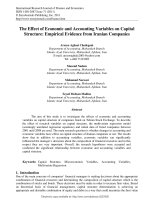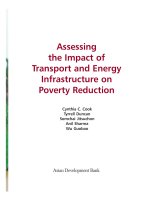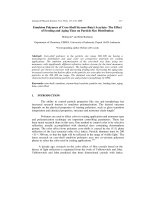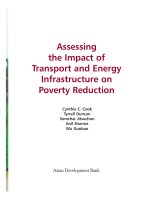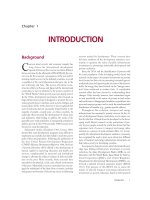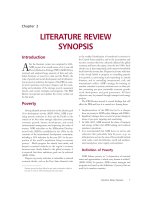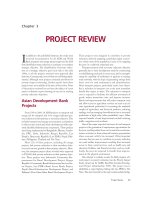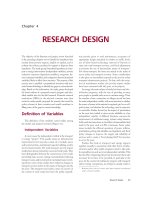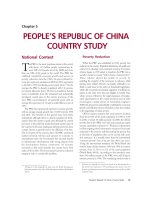The effect of trade and financial liberalization on flationary volatility
Bạn đang xem bản rút gọn của tài liệu. Xem và tải ngay bản đầy đủ của tài liệu tại đây (1.25 MB, 77 trang )
MINISTRY OF EDUCATION AND TRAINING
UNIVERSITY OF ECONOMICS HO CHI MINH CITY
------------------------------
LÊ THỤY PHƯƠNG TÂM
THE EFFECT OF TRADE AND
FINANCIAL LIBERALIZATION ON
INFLATION VOLATILITY
Master thesis in Economic
HO CHI MINH - 2017
MINISTRY OF EDUCATION AND TRAINING
UNIVERSITY OF ECONOMICS HO CHI MINH CITY
------------------------------
LÊ THỤY PHƯƠNG TÂM
THE EFFECT OF TRADE AND
FINANCIAL LIBERALIZATION ON
INFLATION VOLATILITY
Major: Finance - Banking
Major code: 60340201
MASTER THESIS IN ECONOMIC
Supervisor:
Đinh Thị Thu Hồng, Ph.D
HO CHI MINH - 2017
Declaration of Originality
I certify that this thesis is entirely my own work, based on my personal study and
research and that I have acknowledged all material and sources used in its
preparation, whether they be books, articles, reports, and any other kind of
document. I also certify that this thesis has not previously been submitted for
assessment in any form to the University of Economics Ho Chi Minh City or to any
other institution for any other purposes.
Ho Chi Minh, 12 October 2017
Table of Contents
SUB COVER PAGE
DECLARATION OF ORIGINALITY
LIST OF ABBREVIATIONS
LIST OF TABLES
LIST OF FIGURES
ABSTRACT
CHAPTER 1. INTRODUCTION AND RESEARCH QUESTION ....................1
1.1.
INTRODUCTION .............................................................................................1
1.2.
RESEARCH QUESTIONS .................................................................................7
CHAPTER 2. LITERATURE REVIEW ...............................................................8
2.1.
THEORETICAL LITERATURE ..........................................................................8
2.1.1.
Trade Liberalization .............................................................................8
2.1.2.
Financial Liberalization .....................................................................10
2.1.3.
Inflation ...............................................................................................12
2.1.4.
Inflation and Inflation Volatility .........................................................14
2.1.5.
Trade Liberalization and Inflation Volatility......................................16
2.1.6.
Financial Liberalization and Inflation Volatility................................18
2.2.
EMPIRICAL EVIDENCE .................................................................................20
2.2.1.
Inflation and Inflation Volatility .........................................................20
2.2.2.
Trade Liberalization and Inflation .....................................................21
2.2.3.
Trade Liberalization and Inflation Volatility......................................23
2.2.4.
Financial Liberalization and Inflation ...............................................25
2.2.5.
Trade and Financial Liberalization simultaneously and Inflation .....26
CHAPTER 3. DATA AND METHODOLOGY ..................................................28
3.1.
DATA...........................................................................................................28
3.2.
METHODOLOGY ..........................................................................................36
3.2.1.
Econometric Models ...........................................................................36
3.2.2.
Statistical Approaches ........................................................................37
CHAPTER 4. EMPIRICAL RESULTS ..............................................................39
4.1.
LIBERALIZATION AND INFLATION VOLATILITY ..........................................39
4.2.
ROBUSTNESS ANALYSIS .............................................................................43
4.2.1.
Effect of trade and Financial Liberalization joinly ............................43
4.2.2.
Adding further controls .......................................................................44
4.2.3.
Varying the data frequency .................................................................47
4.2.4.
Varying the Inflation Volatility using annual data .............................50
4.2.5.
Varying the measurement for Financial Liberalization .....................51
CHAPTER 5. IN REFERENCE TO VIETNAM................................................52
CHAPTER 6. CONCLUSIONS............................................................................55
REFERENCES
APPENDIX
List of Abbreviations
CPI: Consumer Price Index
FEM: Fixed effect model
FO: Financial openness
GDP: Gross Domestic Product
GMM: Generalized method of moments
GNP: Gross National Product
GEXP: Government expenditure growth
GROWTH: GDP per capita growth
IFS: International Financial Statistic
IMF: International Monetary Fund
INF: Inflation
OLS: ordinary least squares
POP: Population
REM: Random effect model
RGDP: GDP per capita
TO: Trade openness
VINF: Inflation volatility
VOL: GDP per capita volatility
WDI: World Development Indicator
WEO: World Economic Outlook
WTO: World Trade Organization
List of Tables
TABLE 3.1 EXPECTED SIGNS. .....................................................................................32
TABLE 3.2 DESCRIPTIVE STATISTICS FOR MAIN VARIABLES. .....................................33
TABLE 3.3 DESCRIPTIVE STATISTICS FOR CONTROL VARIABLES USED IN ROBUSTNESS
SECTION. .............................................................................................................33
TABLE 3.4 CORRELATION MATRIX FOR MAIN AND CONTROL VARIABLES. ................34
TABLE 4.1 REGRESSION RESULTS: TRADE OPENNESS AND INFLATION VOLATILITY. .39
TABLE 4.2 REGRESSION RESULTS: FINANCIAL OPENNESS AND INFLATION
VOLATILITY. .......................................................................................................41
TABLE 4.3 REGRESSION RESULTS: THE EFFECT OF TRADE OPENNESS AND FINANCIAL
OPENNESS SIMULTANEOUSLY. ............................................................................42
TABLE 4.4 ROBUSTNESS ANALYSIS: EFFECT OF TRADE AND FINANCIAL OPENNESS
JOINTLY. .............................................................................................................43
TABLE 4.5 ADDITIONAL CONTROLS: TRADE OPENNESS AND INFLATION VOLATILITY.
...........................................................................................................................45
TABLE 4.6 ADDITIONAL CONTROLS: FINANCIAL OPENNESS AND INFLATION
VOLATILITY. .......................................................................................................46
TABLE 4.7 DIFFERENT DATA FREQUENCY: SIX-YEAR WINDOWS. ..............................48
TABLE 4.8 DIFFERENT DATA FREQUENCY: SIX-YEAR ROLLING WINDOWS ................49
TABLE 4.9 INFLATION VOLATILITY USING ANNUAL CPI DATA. ................................50
TABLE 4.10 DE JURE MEASUREMENTS FOR FINANCIAL OPENNESS. ..........................51
TABLE 5.1 REGRESSION RESULTS FOR VIETNAM.......................................................54
TABLE 0.1 HAUSMAN TEST FOR THE FIRST MODEL WITH TRADE OPENNESS.................
TABLE 0.2 HAUSMAN TEST FOR THE SECOND MODEL WITH FINANCIAL OPENNESS. .....
TABLE 0.3 CORRELATION MATRIX OF VARIABLES IN THE FIRST MODEL. ......................
TABLE 0.4 CORRELATION MATRIX OF VARIABLES IN THE SECOND MODEL. ..................
TABLE 0.5 MODIFIED WALD TEST FOR TRADE OPENNESS. ............................................
TABLE 0.6 MODIFIED WALD TEST FOR FINANCIAL OPENNESS. .....................................
TABLE 0.7 REGRESSION WITH DRISCOLL-KRAAY STANDARD ERRORS FOR TRADE
OPENNESS. ..............................................................................................................
TABLE 0.8 REGRESSION WITH DRISCOLL-KRAAY STANDARD ERRORS FOR FINANCIAL
OPENNESS. ..............................................................................................................
TABLE 0.9 UNIT-ROOT TEST FOR VINF .........................................................................
TABLE 0.10 UNIT-ROOT TEST FOR TO ...........................................................................
TABLE 0.11 UNIT-ROOT TEST FOR FO ...........................................................................
TABLE 0.12 UNIT-ROOT TEST FOR RGDP ......................................................................
TABLE 0.13 UNIT-ROOT TEST FOR GEXP ......................................................................
TABLE 0.14 UNIT-ROOT TEST FOR VINFT1 ...................................................................
List of Figures
FIGURE 1.1 INFLATION FROM 1991 TO 2014. ...............................................................2
FIGURE 1.2 EXPORTS, IMPORTS AND FINANCIAL TRANSACTIONS FROM 1991 TO 2014.
.............................................................................................................................3
FIGURE 3.1 SCATTER PLOTS BETWEEN TRADE OPENNESS AND INFLATION
VOLATILITY. .......................................................................................................35
FIGURE 3.2 SCATTER PLOTS BETWEEN FINANCIAL OPENNESS AND INFLATION
VOLATILITY. .......................................................................................................35
FIGURE 5.1 INFLATION, TRADE AND FINANCIAL OPENNESS IN VIETNAM .................53
Abstract
This thesis provides evidence for the relationships between trade liberalization and
inflation volatility, and between financial liberalization and inflation volatility.
Using a set of dynamic panel data for 142 emerging market and developing
countries over the period of 1991-2014, this research finds statistically significant
associations between each openness variables and inflation volatility. The
robustness analyses also consider other control variables, different time windows
and different measurements for inflation volatility as well as financial liberalization.
The same result is consistently observed for both trade and financial openness,
suggesting that trade and financial liberalization are associated with lower inflation
volatility.
1
CHAPTER 1.
Introduction and Research Question
1.1. Introduction
Inflation and its volatility are some of the most important figures which have
received lots of attention from economic experts as they affect economic stability
and development. Economists and monetary policy practitioners generally
recognize that low levels of inflation and its volatility would render efficient and
grown economy. Bruno and Easterly (1998) suggests that high inflation is harmful
to the economy. In addition, many previous studies reveal the adverse effects of
high inflation such as declines in real wage, discouragement to investment,
decreases in competitiveness, and reduction in the value of savings in the economy.
While the belief that inflation is detrimental to the economy is strong, the topic of
inflation volatility has also received great interests from scholars. Elder (2004) and
Fatás and Mihov (2005) suggest that high volatile rate of inflation can weaken
economic growth throughout their studies. In fact, some other studies have
suggested certain disturbing effects inflation volatility may impose on an economy
(Golob, 1994 and Friedman, 1977) which will be discussed in more detail in the
later sections. Because the impacts inflation and inflation uncertainty put on real
things (e.g. employments. investments and returns), controlling for both inflation
and its uncertainty is critical to macroeconomic policies.
In the past decades, the world has experienced two distinctive economic trends.
First, on average, many countries have seen signs of disinflation over the years.
Second, countries have liberalized their trade policies so that they are engaged in
more trades across the globe. Beside the rises in liberalization of trade, increases in
international capital flows have also been observed recently (Ball, 2006). Lane and
Milesi-Ferretti (2006) observe a rapid expansion of both foreign portfolio
investment (FPI) and foreign direct investment (FDI) since the 1990s.
Data taken from the World Economic Outlook (WEO) database is used to illustrate
the mentioned trends. Figure 1.1 represents the percentage change in inflation while
2
figure 1.2 shows volume of exports and imports as well as net financial
transactions. As can be seen from figure 1.1, inflation for the world on average
shows a downward trend. A trend line, drawn for inflation in emerging market and
developing countries, also show a strong decreasing trend. Figure 1.2 illustrates
considerable increasing trends in exports, imports and financial transactions for
emerging market and developing countries. Volume of trade and net financial
transactions are calculated in U.S. dollars. Even though the graph shows various
fluctuations, the trend lines do show increases in trades and financial transactions.
Figure 1.1 Inflation from 1991 to 2014.
Fig. 1.1 Scatter plots with smoothing lines for the percentage change in inflation based on
average consumer prices for emerging market and developing countries, advanced
economies and the World from 1991 to 2014. The linear trend line is also shown for
emerging market and developing economies. Data source: The World Economic Outlook
database, April 2017 edition.
3
Figure 1.2 Exports, Imports and Financial transactions from 1991 to 2014.
Fig. 1.2 Scatter plots for the volume of total export and import and net financial
transactions for emerging market and developing countries from 1991 to 2014. Data is in
billions of U.S. dollars. Data source: The World Economic Outlook database, April 2017
edition.
Despite the existence of this recent phenomenon, empirical studies in the past have
mostly focused on the effect of trade liberalization, but not on financial
liberalization. In this thesis, the main objective is to examine the relationship
between economic liberalization and inflation volatility aiming to confirm if the
three mentioned trends are indeed related. Particularly, it is of interest to investigate
the influences of trade and financial liberalization on inflation volatility for
emerging market and developing countries.
There exist several studies that relate inflation to other variables such as political
instability (Aisen and Veiga, 2007), central bank independence (Cukierman et al,
4
1992), exchange rate regimes (Bleaney and Fielding, 2002) and fiscal policies
(Rother, 2004). The relation between economic openness and inflation remains one
of the most widely researched topics. Many researchers find that trade openness
leads to lower inflation figures when it is expanded (Romer, 1993 and Lane, 1997).
Romer finds that in a more open economy, government generates more revenue
from a given tariff so that governments become less dependent on other sources of
revenue such as seignorage. As a result, the costs of inflation would be larger in
more open economies, thus reduce inflationary shocks generated by policy makers.
Empirically, previous finding with regards to this relationship is contrasting. While
Romer (1993), Lane (1997), Gruben and McLeod (2004) support negative links,
Narayan, Narayan and Mishra (2011) propose a positive effect. Alfaro (2005) and
Shambaugh and Klein (2010) did not find any statistically significant effect of trade
liberalization on inflation.
In regards to financial openness (capital flow openness), financial openness brings
possibilities for risk reduction by diversifying portfolio and consumption
smoothing. Besides, it may have an effect on policy makers’ decisions to undertake
better monetary policies. As pointed out by Bartolini and Drazen (1997), they
suppose that capital flow openness provides more access to foreign capital,
increases the elasticity of demand for money, reduces the incentive to print money
excessively and decreases inflation rate. In the beginning of 1990s, there was a
general belief that relaxation of capital controls brings benefits similar to relaxation
of trade barriers (Gupta, 2008). After the financial crisis, the relationship between
financial openness and inflation became questionable since worst affected countries
were the ones that adopt financial liberalization. Empirical studies have also showed
ambiguous findings. In particular, Gruben and McLeod (2002) and Tytell and Wei
(2004) present that capital account openness tends to reduce inflation. Rodrik
(1998) concludes that there is no proof of association. McKinnon and Mathieson
(1981), in contrast, suggested that the imposition of capital controls reduces
inflation.
5
On the one hand, the relation between openness and inflation volatility has been
studied by some economists, nevertheless the number of the studies is not abundant.
Most of their studies focus on the relation between trade openness and inflation
volatility (Granato, 2006 and Bowdler and Malik, 2015). Bowdler and Malik (2015)
find an evidence for a negative impact of trade openness on volatility of inflation.
On the other hand, it is difficult to find a study about the effect of financial
openness on inflation volatility. To the best of my knowledge, there have been very
few studies which examine the effect of both trade and financial liberalization on
inflation. Ghosh (2014) used both de jure and de facto measurements to show how
inflation is influenced by openness and exchange rate regimes. Badinger (2008)
provides evidence on the link between inflation and globalization, referred to as
trade and financial liberalization.
This thesis aims to close the literature gap by conducting a research about the effect
of both trade and financial liberalization on inflation volatility. This will give
information on the ultimate relationship between openness and inflation volatility.
In this thesis, a dynamic panel model using a dataset spanning 142 countries, which
are emerging market and developing countries, in the world from 1991 to 2014 is
used.
The results indicate that liberalization of trade and financial are associated with
lower inflation volatility. The effect of liberalized trade is consistent with evidence
presented by Bowdler and Malik (2015). With regards to financial openness, it is
also aligned with previous studies (Gruben and McLeod, 2002 and Tytell and Wei,
2004), which indicate negative effect of financial liberalization on inflation.
The remainder of this thesis is organized as follows. Section 2 discusses both
theoretical and empirical evidences, which include definitions and the channels
through which economic openness effect inflation and inflation uncertainty.
Empirical literature provides summary and brief discussions on relevant researches
relating to this topic. Section 3 describes the dataset in details, including descriptive
6
statistics, the econometric models and statistical approaches. Section 4 outlines
empirical results for both trade and financial openness, and robustness tests for a set
of other control variables, different data frequency and measurements. Section 5
refers to the current economic trends any basic relevance relating to Vietnam
exclusively. Finally, section 6 concludes on the evidence and informative reference
for policy makers.
7
1.2. Research Questions
As stated previously, the main objectives rest on the links between trade
liberalization and inflation volatility, and between financial (capital account)
liberalization and inflation volatility. The specific research question specifies as
follows.
- Is there any (statistically significant) association between openness (i.e. trade and
financial) and inflation volatility?
8
CHAPTER 2.
Literature Review
2.1. Theoretical Literature
2.1.1. Trade Liberalization
2.1.1.1.
Summary
Trade openness is defined as the relaxation of trade barriers, in term of tariffs,
quotas or other restrictions, allowing easier movements of goods and services across
borders. Trade liberalization can be achieved by mean of joining free-trade groups
or agreements. The adoption of free trade can occur on a unilateral or bilateral basis
between countries. Members of this group of countries negotiate and agree on a set
of relaxed trade restrictions or even complete removal of trade barriers between
them. They, however, manage their own trade policies with other non-members.
2.1.1.2.
Advantages
Trade openness brings many benefits to all trading partners as follows. First,
diversifying trade means that domestic country can trade with international markets,
and have access to high quality and less expensive products. This supports for a
more efficient economy, increased productivity and an improvement of living
standard. Consumers ultimately benefit from free trade as they now have access to a
range of products with lower prices and more diversified in term of quality and
options available. Second, trade offers specialization based on comparative
advantage, which means producers can reach their optimal welfare when they
concentrate in the production of the products that can be produced at a lower
opportunity cost. Countries enjoy the economic benefits from capturing the area of
comparative advantage and allocating factors of productions, i.e. land, labor, capital
and entrepreneurship, effectively. Third, there has been considerable debates among
experts that trade liberalization brings opportunities for job creation. They suppose
that exporting sectors increase employment due to the increase in supply of
products in these sectors, but decreased employment occurs in importing sectors
9
because of increased competitions. In general, trade liberalization motivates the
increase in consumer’s purchasing power, which leads to more job growth. Fourth,
liberalized trade aids to limit monopolistic behavior in the economy. Because the
participation of international firms creates competition, local firms adapt to this new
environment by modifying their operation such as decreases in price charging in the
market. Fifth, trade liberalization fosters the competition of local firms due to
existence of overseas markets. With appropriate enhancing national policies to
manage trade, liberalization encourages competition and investments. This
promotes local firms to produce more effectively with lower costs, technology
innovation and efficient resources. Finally, as mentioned previously, liberalization
of trade boosts economic growth as firms engage in more competition and improved
productivity. Economic development enhances living standard and real wages.
Overall, liberalized trade is recommended to be engage on a multilateral basis so
that many nations can enjoy the benefits it provides.
All in all, some of the advantages from trade liberalization relate to inflation.
Specifically, trade openness brings diversified basket of products and the more
choices for consumers. In addition, trade liberalization makes the market more
competitive, hence it limits the increase in prices and contributes to disinflation.
Moreover, it makes policy makers more considerate with the shocks to inflation.
These create more motivation to research on the relationship between trade
openness and inflation volatility.
2.1.1.3.
Disadvantages
Aside from the advantages liberalized trade bring, it has also received several
criticisms. However, its drawbacks are not stem from the principle of trade
liberalization, but the failure of implementation. The following briefly discuss some
of its disadvantages. Firstly, imbalance in bilateral trade is caused by the
disproportion in supply and demand between corresponding countries. In the long
run, it is difficult to become a prosperous economy through participation in trade
10
with international markets, if it is a poor and less diversified economy. Next, the
complex rules and contracts among participants might raise higher costs in
international trade as partners monitor and ensure that agreed terms are followed.
Besides, the more dependence on international markets a nation becomes the more
exposure to an unstable economy it suffers. Businesses and consumers are subject
to more risks in the event of negative shocks experiencing by their trading partners.
Additionally, infant firms may find it difficult to grow and participate in such
competitive markets without any protection policy from the government. When
trade openness occurs in these economies, the well-established or dominant firms
can swallow them easily. Finally, dumping is often known as an issue that goes
beyond the control of firms in the trading environment. Firms with excessive
inventories may market their products at a price lower than costs. Sectors operating
at full equilibrium may then find it extremely challenging to compete. Given such
conditions, market participations may employ unethical practices to improve their
market position. These behaviors may include improper use of intellectual property,
mimic well-known trademarks and misrepresentation.
2.1.2. Financial Liberalization
2.1.2.1.
Summary
Financial openness is defined as the financial system of domestic country unites
with that of the rest of other countries in the world. The country, which integrates
with international financial markets, is obligated to relax their rules and
regulations. Integration holds when an open economy goes through a rise in cross –
country capital movement which involves not only the interaction between both
debtors and creditors in local country and the international markets, but also the
participation of international financial intermediaries.
11
2.1.2.2.
Advantages
Financial openness brings many benefits to all participants, especially ones in
developing and emerging countries. Particularly, financial liberalization help
countries’ financial system become more stable and better regulated. Basically,
financial liberalization motivates the financial system in two ways. First of all, there
are more available funds through financial liberalization. This is because funds can
flow liberally from countries with excess capital to countries with scarce capital for
production or investment. Beside the funds that are available domestically,
borrowers now have access to capital from foreign investors who believe in the
potential growth of the domestic market. Furthermore, the local debtors are imposed
with market discipline by foreign investors as they usually have more restrictions
when invest internationally. Second of all, the financial infrastructure is
strengthened and this leads to a decrease in the issue of asymmetric information.
This brings more transparency and efficiency in the financial infrastructure.
Additionally, when asymmetric information exists, the market does not operate as
efficiently. Financial liberalization then also improves the problem of adverse
selection and moral hazard in a way that asymmetric information is minimized.
Besides, when foreign bank enters local country, it improves the financial
infrastructure in other dimensions (Mishkin, 2003). First, foreign banks are less
sensitive to negative shocks that impact home country, as they are able to diversify
risks by having access to different sources of funds from around the world. Second,
when banks have issue with solvency, governments will not be willing to bail out
due to the existence of dominated foreign banks. Hence, this promotes not only a
more prudent behavior by banking institutions, but also a decrease in moral hazard.
In general, financial openness is one of the factors affecting inflation and inflation
volatility through its advantages. As mentioned previously, when more investments
and funds flow into a country, government tends to limit printing money and
considers any decision thoughtfully to avoid any adverse effects on funds from
12
abroad. These lead to a decrease in inflation of the country, thus this study has more
evidences to execute estimate regarding the effect of financial liberalization on
inflation volatility.
2.1.2.3.
Disadvantages
Despite the fact that financial openness brings tremendous benefits, it has been
found to be associated with crises. First, as foreign and domestic investors reinforce
market discipline, deterioration of market fundamentals can lead to a crisis.
Specifically, investors usually overreact with both bad and good news, so minor
changes in fundamental might change investors’ perception of risk dramatically.
Second, the crisis can be caused by the international financial markets’
imperfection, which creates bubbles and speculation. Third, contagion is a factor
that relates to financial crises in the world. This presents through two dimensions
including real links and herding behavior. Regarding first dimension, real links are
associated with trade in a way that trading partners are influenced by external
factors such as exchange rate. A change in exchange rate in one country will
eventually transmit across countries. Next, I move on to herding behavior, which
pertains to asymmetric information. Due to the cost of obtaining information,
investors tend to rely on reactions in other markets to predict future prices. This
may not be a reliable source of information as each individual market state is
distinctive.
2.1.3. Inflation
2.1.3.1.
Summary
Inflation is described as the general increase in the price level of goods and services.
This leads to various effects on the economy such as the decrease in purchasing
power because people have to pay more for a similar basket of goods. However,
inflation does offer both favorable and unfavorable consequences. If government
can control and use inflation cautiously, it contributes to economic development.
13
Otherwise, if government is in incapable of managing inflation, it may threaten
economic stability and development.
2.1.3.2.
Advantages
Inflation could be a good thing, depending on what causes it and the state of the
economy. The followings are two circumstances in which inflation brings favorable
influences. First, people anticipate that the prices will continue to increase given the
existence of inflation. Hence, consumers will attempt to buy now, as much as they
could afford, instead of buying later and paying more ultimately. This leads to
consumers demanding more goods and services, hence factories and companies
need to employ more labors to satisfy customers’ demand. In this case, inflation
decreases unemployment and stimulate economic growth.
Second, inflation suggests that deflation is less of a risk. When there is a decrease in
the level of prices, people suppose that prices will continue to fall. Therefore, they
try to limit their purchases goods and services as they are afraid that the prices will
fall even more. This leads to a drop in the demand of goods and services. As
businesses adjust their operations accordingly, unemployment rise while wages
slump. As a result, decreasing income reduces the demand further, leading to even
lower prices; deflation is worsened. Deflation is therefore considered a bigger evil
than inflation.
2.1.3.3.
Disadvantages
Firstly, it is important to distinguish between expected inflation and unexpected
inflation. Expected inflation, which can induce menu costs and shoes leather costs,
is what economic agents anticipate and have accounted for this in their economic
decisions. Generally, lenders lose in the case of higher inflation than expected,
while borrowers lose when inflation is lower than expected. This uncertainty in
inflation gives rise to a lending premium which then reduces the efficiency of
economic activities. Unanticipated inflation can generate risk premium in
borrowing rates, reduce informational signal of market prices and lead to an
14
involuntarily transfer of wealth between borrowers and lenders. High inflation is
usually detrimental to economic growth through the reduction in investments in the
economy. This is caused by the uncertainty about future prices; so many investors
become indecisive and are unable to predict the return on their investments that they
will receive in the future.
Moreover, a country can become uncompetitive in the international markets when
inflation causes currency depreciation. This leads to a decrease in export, a
deduction in demand for goods and an adverse effect on the economy.
When inflation is high, central banks try to increase interest rate to manage inflation
by reducing money supply. As a result, many people and companies face high
interest rates on loans. They are now responsible for higher interest obligations.
Moreover, if they are not able to manage their finance well, they will become
insolvency or bankruptcy, which may lead to a crisis in the economy.
Finally, the worst scenario, which has been researched by many experts, is
hyperinflation. Hyperinflation happens when inflation accelerates rapidly and goes
out of control. When people acknowledge hyperinflation, they anticipate higher
inflation. As a result, they buy more now to avoid paying higher price in the future;
creating shortages of goods. As a result, people use up their savings, cash becomes
worthless and creditors go bankrupt as loans decrease in value and people are
reluctant to make deposits. In this case, the economy depresses completely and
government collapses, leaving the economy with chaos and disasters.
2.1.4. Inflation and Inflation Volatility
Inflation volatility refers to the standard deviation of inflation rates, which is based
on the change in Consumer Price Index, over a calendar year. Volatility of inflation
represents the dispersion of both expected and unexpected components of inflation.
Unexpected changes create inflation uncertainty, which produces adverse economic
effects referring to as ex-ante and ex-post effects (Golob, 1994). In fact, Milton
15
Friedman (1977) has argued that inflation volatility may cause more disturbing
effects than the levels. High volatility of inflation creates conflicts in prices which
create a gap between prices prevailing in the economy and market prices without
the presence of inflation volatility. Because high inflation volatility leads to price
volatility, investors would be less willing to invest in such a risky market.
Specifically, with regards to existing contractual obligation, price uncertainty gives
rise to higher risks and change wealth distribution unexpectedly.
There also exists a conventional explanation; known as the Friedman-Ball
Hypothesis, on how inflation uncertainty changes with inflation involves monetary
policy implementations. When inflation levels are low, authorities put their effort to
maintain it low and stable. When inflation levels are high, it is unpredictable
whether the government will engage in inflation controls and suffer the costs of
recession, and policy makers tend to adopt economic policies to manage inflation.
Inflation variability increases as a result of uncertainty in monetary policy. This
justification is also supported by Ball (1992) and Fischer (2002). In contrast,
Pourgerami and Maskus (1987) argue that surged inflation induces economic agents
to invest more resources to anticipate future inflation rates better, thus this leads to
lower inflation uncertainty.
With regards to the sign of the relationship between inflation and inflation
uncertainty empirically, Golob (1994), Ball (1992) and Friedman (1977) suggest
positive correlation between inflation and inflation uncertainty. Consistently, Davis
and Kanago (1998), Hartmann and Herwartz (2012) and Kim and Lin (2012) find a
positive association between inflation and inflation volatility. Lastly, there exists
opposing explanations as well as empirical evidences on this relationship; however,
the studies supporting a positive association seem to overwhelm. Finally, inflation
volatility, when used as a measurement, has its limitation which is its inability to
distinguish between expected and unexpected portion of the change in inflation.

